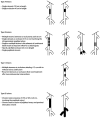Current approach to the diagnosis and treatment of femoral-popliteal arterial disease. A systematic review
- PMID: 21037847
- PMCID: PMC2842962
- DOI: 10.2174/157340309789317823
Current approach to the diagnosis and treatment of femoral-popliteal arterial disease. A systematic review
Abstract
Peripheral arterial disease (PAD) is a common manifestation of atherosclerosis affecting 5 million adults in the United States, with an age-adjusted prevalence of 4% to 15% and increasing up to 30% with age and the presence of cardiovascular risk factors. In this article we focus on lower extremity PAD and specifically on the superficial femoral and proximal popliteal artery (SFPA), which are the most common anatomic locations of lower extremity atherosclerosis. We summarize current evidence and perform a systematic review on the diagnostic evaluation as well as the medical, endovascular and surgical management of SFPA disease.
Keywords: Peripheral arterial disease; diagnosis; management.; popliteal artery; superficial femoral artery.
Figures






References
-
- Hirsch AT, Haskal ZJ, Hertzer NR, et al. ACC/AHA 2005 Practice Guidelines for the management of patients with peripheral arterial disease (lower extremity, renal, mesenteric, and abdominal aortic): a collaborative report from the American Association for Vascular Surgery/Society for Vascular Surgery, Society for Cardiovascular Angiography and Interventions, Society for Vascular Medicine and Biology, Society of Interventional Radiology, and the ACC/AHA Task Force on Practice Guidelines (Writing Committee to Develop Guidelines for the Management of Patients With Peripheral Arterial Disease): endorsed by the American Association of Cardiovascular and Pulmonary Rehabilitation; National Heart, Lung, and Blood Institute; Society for Vascular Nursing; TransAtlantic Inter-Society Consensus; and Vascular Disease Foundation. Circulation. 2006;113:e463–654. - PubMed
-
- Selvin E, Erlinger TP. Prevalence of and risk factors for peripheral arterial disease in the United States: results from the National Health and Nutrition Examination Survey, 1999-2000. Circulation. 2004;110:738–43. - PubMed
-
- Pasternak RC, Criqui MH, Benjamin EJ, et al. Atherosclerotic Vascular Disease Conference: Writing Group I: epidemiology. Circulation. 2004;109:2605–12. - PubMed
-
- Hirsch AT, Criqui MH, Treat-Jacobson D, et al. Peripheral arterial disease detection, awareness, and treatment in primary care. JAMA. 2001;286:1317–24. - PubMed
-
- Leng GC, Lee AJ, Fowkes FG, et al. Incidence, natural history and cardiovascular events in symptomatic and asymptomatic peripheral arterial disease in the general population. Int J Epidemiol. 1996;25:1172–81. - PubMed
LinkOut - more resources
Full Text Sources
Other Literature Sources
Medical

